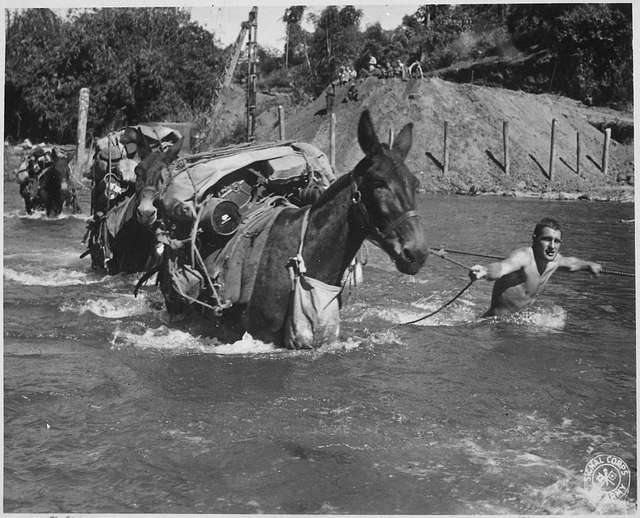Summary | Excerpt | Reading Guide | Reviews | Beyond the Book | Read-Alikes | Genres & Themes | Author Bio

A Novel
by Derek B. MillerThis article relates to The Curse of Pietro Houdini
 One of the characters in Derek B. Miller's novel The Curse of Pietro Houdini is a limping mule named Ferrari. The author notes that mules were used extensively during World War II in the Italian theater, in areas where trucks couldn't go, such as mountain passes and forests.
One of the characters in Derek B. Miller's novel The Curse of Pietro Houdini is a limping mule named Ferrari. The author notes that mules were used extensively during World War II in the Italian theater, in areas where trucks couldn't go, such as mountain passes and forests.
Mules are remarkable creatures that have been used as pack animals for millennia. The offspring of a male donkey and a female horse, mules inherit the best characteristics of each. They're hardier, eat less, and live longer than horses, and they also have harder hooves, making them ideal for rocky terrain. They're less stubborn but more intelligent than donkeys, which makes them easier to train.
It's not known precisely when mules first appeared, but it's thought they arose organically in areas where wild horses and donkeys roamed, likely in Central Asia. The practice of breeding them dates back at least 3,000 years. They're mentioned numerous times in the Bible's Old Testament, and it's thought they were common by the reign of Israel's King David (1090-970 BCE). It's said that mules were introduced to the Americas by Christopher Columbus, but they didn't become popular in the United States until bred and championed by the first president, George Washington. Mules served with distinction during America's Civil War as well as World War I.
All types of animals served throughout WWII, including not only mules and horses but dogs, pigeons, elephants, and camels. Mules made up a sizable percentage of this wartime menagerie and were used by both Allied and Axis powers, although the Russian and German armies predominantly relied on horses. The United States alone shipped 10,000 mules to theaters of war across the world, with most deployed to either the jungles of Burma (now Myanmar) or the mountains of Italy.
In the United States, the Quartermaster Corp was responsible for breeding, training, and shipping the animals used in combat. Mules would be gathered at a remount depot, trained for four months, and then shipped overseas in vessels dedicated to the purpose. Known as "floating barns," they usually held 450-500 animals, their handlers, and enough food and water for three months. Like people, mules experienced issues like motion sickness and injuries due to falling in rough seas. Once at their destination, if land were close enough, a lead mule would stroll down the deboarding ramp and the others would follow, but if the boat were farther offshore the animals would be lowered by a winch until they were just above the water and then dropped. The poor beasts would have to swim to shore from there.
Once arriving at the combat zone, the mules would usually be loaded onto trains and sent to the front lines (although some were actually parachuted in). Most were either designated to carry supplies to the troops or tote artillery. In Italy, the Allied armies needed 250 mules a day to keep soldiers supplied. Many of the animals had to be purchased locally, with the going rate between $80 at the start of the war and $250 later on (about $1,400 and $4,300 respectively, in today's dollars).
Unfortunately, the animals employed by the military did not have a happy life. They faced the same dangers as soldiers did, and countless died from bullets and bombs, injuries, starvation, thirst, and exposure. Soldiers sometimes used the animals as shields from enemy fire, and in some extreme instances the mules became a food source. Those used in Italy during WWII were redeployed to Greece after hostilities ended to battle Communist forces during the Greek Civil War (1946-1949).
US Army mules last saw action in the Korean War (1950-1953), although the United States didn't send animals to the area. Instead, they captured them from the North Koreans and Chinese Communists, who relied on them heavily. Interestingly, one of the captured mules had a brand that indicated it was a US mule that had been part of the Burma campaign in WWII.
The last US Army mules were decommissioned on December 15, 1956, and the remaining 322 animals were sold or transferred to the National Park Service and the Forest Service.
US military mule skinner leading mules in WWI, courtesy of National Archives and Records Administration
Filed under Cultural Curiosities
![]() This "beyond the book article" relates to The Curse of Pietro Houdini. It originally ran in February 2024 and has been updated for the
January 2025 paperback edition.
Go to magazine.
This "beyond the book article" relates to The Curse of Pietro Houdini. It originally ran in February 2024 and has been updated for the
January 2025 paperback edition.
Go to magazine.
Your guide toexceptional books
BookBrowse seeks out and recommends the best in contemporary fiction and nonfiction—books that not only engage and entertain but also deepen our understanding of ourselves and the world around us.